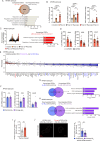Astrocyte priming enhances microglial Aβ clearance and is compromised by APOE4
- PMID: 40813385
- PMCID: PMC12354888
- DOI: 10.1038/s41467-025-62995-1
Astrocyte priming enhances microglial Aβ clearance and is compromised by APOE4
Abstract
The innate immune system can develop a form of memory called priming, where prior exposure to a stimulus enhances subsequent responses. While well-characterized in peripheral immunity, its function in brain-resident cells such as astrocytes under non-disease conditions remains unclear. Here we show that human astrocytes derived from the induced pluripotent stem cells of healthy female donors, but not microglia, acquire a primed state following transient immune stimulations. Upon subsequent exposure to amyloid-β (Aβ), these astrocytes secrete elevated levels of cytokines and promote microglial Aβ uptake. In contrast, astrocytes carrying the Alzheimer's disease (AD) risk allele APOE4 exhibit reduced priming and fail to support microglial phagocytosis. These findings are validated in astrocyte-microglial co-cultures, cerebral organoids, and male mice, where astrocyte priming enhances Aβ clearance in an APOE4-sensitive manner. Our findings identify astrocytic immune memory as a modulator of microglial function and Aβ pathology, providing insights into how early protective responses in AD may be disrupted by genetic risk factors.
© 2025. The Author(s).
Conflict of interest statement
Competing interests: The authors declare no competing interests.
Figures





References
-
- de Laval, B. et al. C/EBPβ-dependent epigenetic memory induces trained immunity in hematopoietic stem cells. Cell Stem Cell26, 657–674.e8 (2020). - PubMed
MeSH terms
Substances
LinkOut - more resources
Full Text Sources

